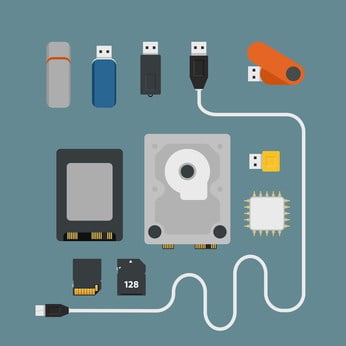NAND memory is a specific type of flash memory defined as “non-volatile storage technology.” Unlike many other types of memory, it doesn’t require active power to retain and store data. According to Wikipedia, non-volatile storage technology includes read-only and NAND flash memory.

NAND, created as a solution to reduced costs and chip capacity. Allowing flash memory to compete with magnetic storage such as hard disks. Since its introduction, NAND, used in devices to hold large files at faster speeds. Its use increases file transfer speeds and bandwidth. Some of your favorite devices use NAND flash, including USB drives, external USB drives, MP3 players, cell phones, MicroSD and digital cameras. NAND flash has no moving parts. Therefore, NAND flash runs on less power and creates less heat.
A Solid Type of Memory, but Still Fallible.
One of the most notable benefits of NAND memory is its ability to resist file corruption. Unlike many other types of memory on the market, NAND is composed of a finite number of write cycles. As a result, probable memory failure will take a while to occur. This type of memory gradually incurs failures over individual cells. In most cases, instead of a sudden memory failure or corruption, a device with NAND memory will experience overall performance reductions prior to memory failure and file damage. Referred to as wear-out, it gives the user a solution to back up their data and acquire a new storage drive. Thus, preventing failures before a catastrophic crash that results in massive data loss.
Once a device’s NAND memory wears out, the user will simply purchase new memory. When inserted into a storage device, the new flash memory will allow it to function normally. In essence, additional storage costs are passed on to the consumer, which has lowered the price of electronic devices significantly.
Current Industry Trends in File Storage.
The Information Technology and Consumer Electronics industries eat NAND memory for breakfast, lunch, and dinner! Today, we find this type of memory in all of our most popular and highly used products, including:
- Smart Phones & Cellphones
- Memory Cards, microSD, SD
- USB Flash Devices
- GPS Devices
- SSD Drives, Solid State Storage Drives
- MP3 Players
- Digital Cameras
- Data Collection Systems, as used by NASA, Seismograph Instruments, etc.
Solid State Drives (SSD Storage).
NAND flash memory chips inside solid state drives stores actual data. SSDs are at its prime, and has been making its mark for over a decade now. When this technology broke the market, it improved PCs overall performance. Now, you’ll find this storage option within laptops, and desktops, rather than just HDDs. Over the years, SSD interfaces has expanded to adapt to other technologies. The traditional 2.5-inch SATA SSD, SATA M.2, and PCIe M.2 drives are all serviced by eProvided. Our SSD recovery service allows professionals, and consumers to restore all data loss.
NAND flash memory built into today’s storage devices creates for a longer lifespan. The cost of SSDs has gone down quite a bit since it’s breakthrough with mainstream devices. These drives proved themselves more reliable, and resilient than traditional hard drives. Our data recovery experts restore deleted, formatted, and unrecognized SSDs every day. We specialize in NAND flash memory data loss for over 20 years. If anyone can retrieve your data, it’s our certified, and dedicated technicians.
NAND Flash Memory, New Developments.
As technology continues to advance, new breakthroughs in NAND memory will continue to be achieved. Memory chips are continually growing smaller while increasing the maximum read and write cycles and lowering overall voltage demands. What does this mean for you? It means the future of memory and storage is about to grow faster, larger, and much more cost-effective for the everyday user.
NAND technology is quickly becoming one of the most effective and efficient types of memory on the market. In the years to come, it’s predicted to become the only type of memory in data storage devices on the market.
